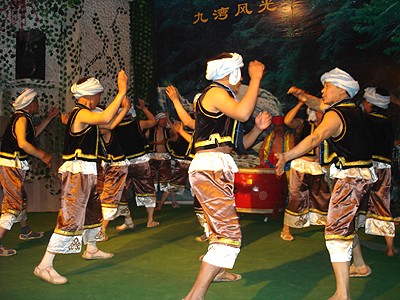| Tools: Save | Print | E-mail | Most Read |
| Funeral Dance of the Tujia People |
| Adjust font size: |
Funeral dance is a special custom for the Tujia Ethnic Group, but the average person without any background knowledge will find the concept unimaginable. Men and women, old and young, gather around the coffin and sing, dance and enjoy themselves through the night. They wear colorful clothes as if they were attending a happy celebration. Relatives of the deceased will join in when the celebrations reach their peak. Only the men dance at this stage while women watch. Also called sayi'erhe in the local language, funeral dance is to be found in the middle reach areas of Qingjiang River -- the second branch of Yangtze River -- such as Changyang and Wufeng Tujia Autonomous Counties in Hubei Province. The recorded history of the funeral dance can be traced back to Tang Dynasty (618 - 907). Prof. Zhang Zhengming, who is an expert on Chu History at the School of Historical Culture of Central China Normal University (CCNU), said the dance is likely to have originated from a war dance because of some of the movements used. Bai Xiaoping, an expert on the funeral dance, has researched the subject for three years. She kept a close watch on the funerals and selected nine of them to feature in her book on the subject with photos and descriptions. According to Bai, the funeral dance is a complex of movements, songs and music and has its unique artistic values. The drummer is also the singer and the songs are about love and all aspects of life. The songs are called wujuzi because they are in a five-sentence pattern. They are all happy songs with most being sung by males in high-pitched voices. Bai said the dance reflects Tujia people's philosophy of life and death. They are open-minded, thinking death as natural as the rotation of the four seasons and therefore deserving a happy ending.
But Bai said she's confident that the tradition can be kept for future generations. The funeral dance is an activity involving many participants and has been handed down through generations. Now many cultural departments have recognized the importance of protecting the funeral dance and the tradition itself. (China.org.cn by staff reporter Chen Lin, May 9, 2006) |
| Tools: Save | Print | E-mail | Most Read |
 |
| Related Stories |
|
| Product Directory China Search |
Country Search Hot Buys |
